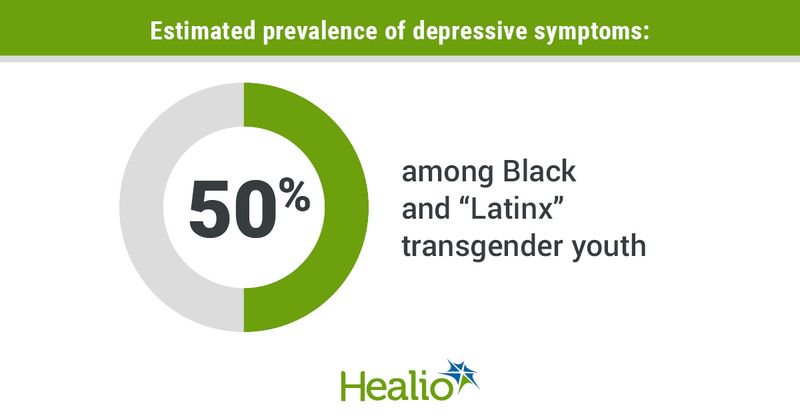Black, 'Latinx' transgender youth have significant rates of mental health symptoms
Click Here to Manage Email Alerts
Black and “Latinx” transgender youth had significant mental health symptom rates, according to results of a survey study published in JAMA Network Open.
Researchers noted the importance of considering race/ethnicity and gender identity in clinical services when treating this patient population.

“Black and Latinx transgender adults face a tremendous burden of poor outcomes, including high levels of depression and substance abuse and negative psychosocial experiences, including racial discrimination, transphobia and physical victimization,” Stanley Ray Vance Jr, MD, of the department of pediatrics at the University of California, San Francisco, and colleagues wrote. “To our knowledge, the youth antecedents to these poor adult outcomes for Black and Latinx transgender individuals have not been elucidated.”
The investigators aimed to compare Black and “Latinx” transgender youths’ past-year mental health symptoms and psychosocial factors with those of white transgender youth and Black and “Latinx” cisgender youth. They queried students on their race and whether they were of Hispanic/Latino origin, and then combined race and ethnicity items of interest into three mutually exclusive categories: non-Hispanic/“Latinx” white, with “Latinx” used as a gender-neutral alternative to Latino or Latina; non-Hispanic/“Latinx” Black; and Hispanic/“Latinx.” A peer group included the following categorizations: Black and “Latinx” transgender youth, meant to be inclusive of all transgender students categorized as non-Hispanic/“Latinx” Black and/or Hispanic/“Latinx”; white transgender youth, which included non-Hispanic white youth who selected transgender; and Black and “Latinx” cisgender youth, which included all non-Hispanic/“Latinx” Black and “Latinx” youth who did not select transgender.
In total, the researchers analyzed data of 19,780 individuals who participated in the 2015 to 2017 Biennial California Healthy Kids Survey, which featured a weighted sample that represented California’s secondary school population. Vance and colleagues included 252 Black and “Latinx” transgender youth, 104 white transgender youth and 19,424 Black and “Latinx” cisgender youth in grades nine through 11 in the analytic sample. Past-year depressive symptoms and suicidality served as outcomes. School-based victimization, gender-based harassment, sexuality-based harassment and race-based harassment served as psychosocial risk factors, and school connectedness and caring adult relationships as protective factors.
Results showed 50% (95% CI, 44-57) estimated prevalence of depressive symptoms and 46% (95% CI, 39-52) of suicidality among Black and “Latinx” transgender youth. Black and “Latinx” transgender youth exhibited similar risk for depressive symptoms (adjusted OR = 0.6; 95% CI, 0.4-1.1) and suicidality (adjusted OR = 1.1; 95% CI, 0.6-1.8) and similar risk for all forms of harassment (adjusted OR = 1.5; 95% CI, 0.8-2.6) compared with white transgender youth, according to results of logistic regression models adjusted for grade, living arrangement and reported sex. Moreover, Black and “Latinx” transgender youth exhibited similar levels of victimization (adjusted linear regression coefficient = 0.5; 95% CI, 0.3 to 1.3) and caring adult relationships (adjusted linear regression coefficient = 0.6; 95% CI, 1.4 to 0.09) but lower levels of school connectedness (adjusted linear regression coefficient, 1.6; 95% CI, 2.9 to 0.4) compared with white transgender youth, demonstrated by regression models. Similar analyses revealed Black and “Latinx” transgender youth were at increased risk for depressive symptoms (adjusted OR = 2.7; 95% CI, 2-3.7) and suicidality (adjusted OR = 5.9; 95% CI, 4.3-8), increased risk for and higher levels of all forms of harassment and victimization (adjusted OR = 3.2; 95% CI, 2.4-4.5) and lower levels of school connectedness (adjusted linear regression coefficient = 2.6; 95% CI 3.3 to 1.8) and caring adult relationships (adjusted linear regression coefficient = 0.9; 95% CI 1.3 to 0.5) compared with Black and “Latinx” cisgender youth.
“Organizations such as the Gay, Lesbian and Straight Education Network recommend intersectional approaches in supporting Black and Latinx sexual minority and gender diverse youth,” Vance Jr. and colleagues wrote. “These approaches include supporting student clubs, such as Gay Straight Alliance, and ethnic/cultural clubs collaborating to address their needs and professional development for school staff that addresses unique experiences of these youth. Pediatric and adolescent medicine clinicians should be involved in school-based efforts to address the unique needs of these youth. For example, they could provide in-service training referral resources for school staff and parent-teacher organizations.”
Editor's Note: This story was updated on April 1, 2021, for further explanation of the term “Latinx” as used by the study’s authors.

